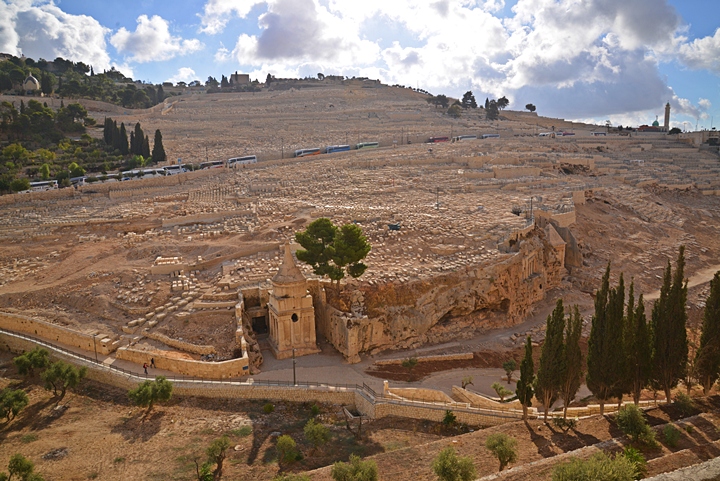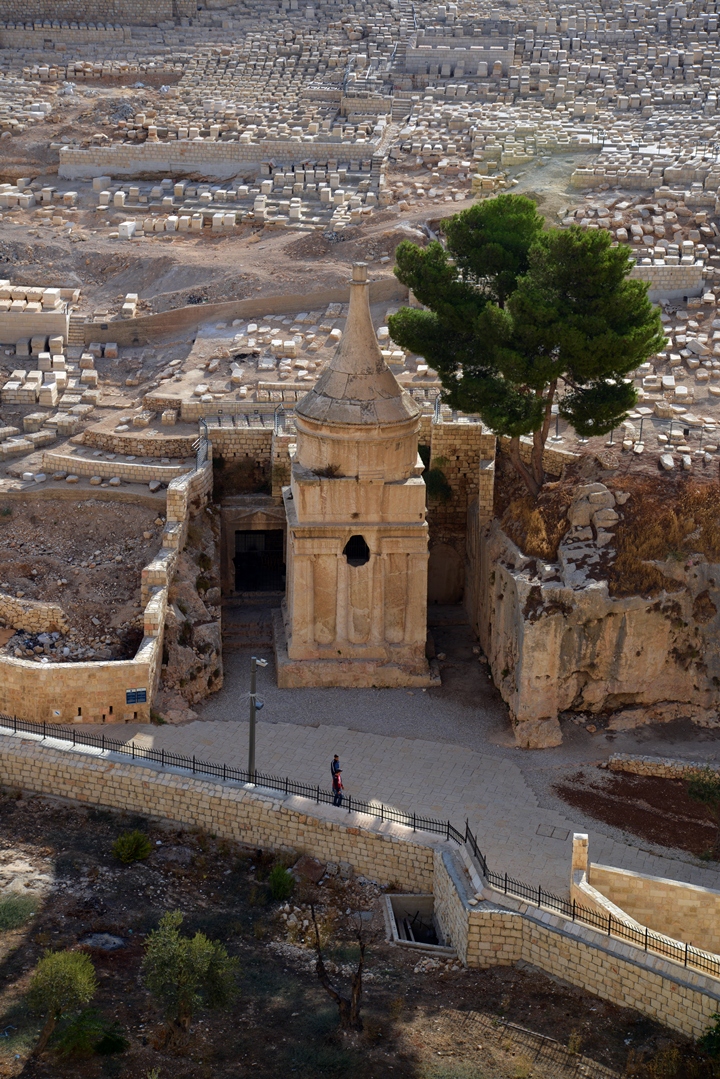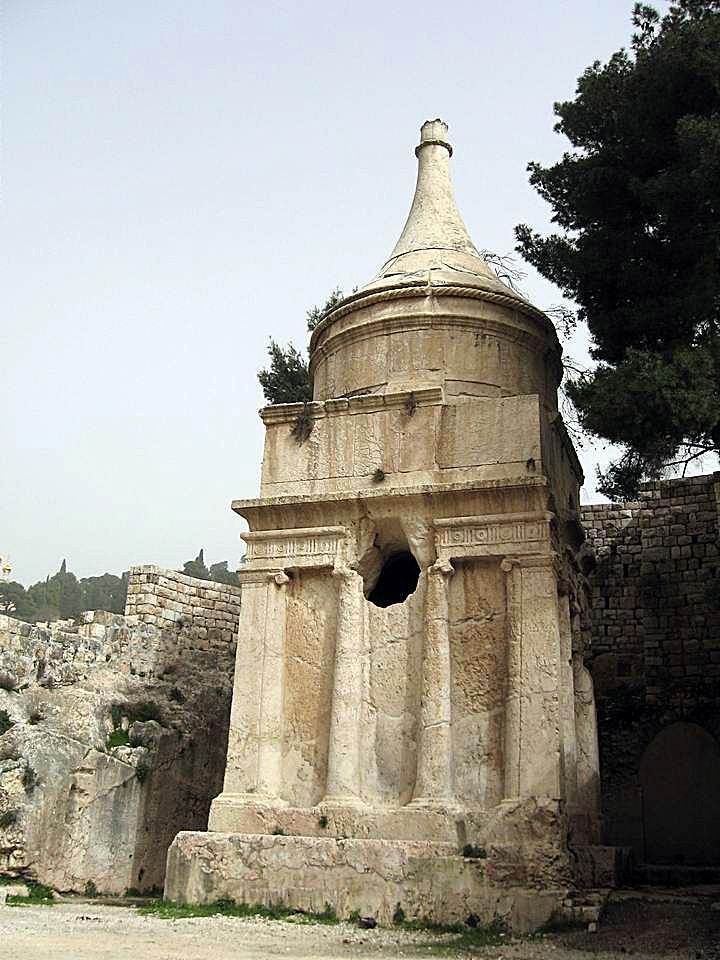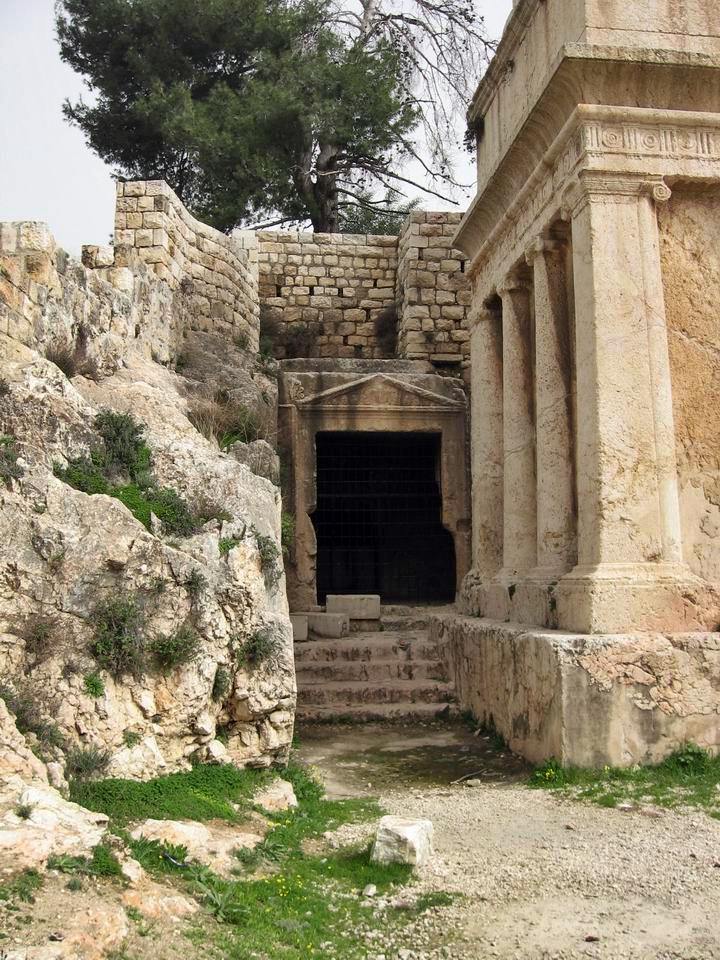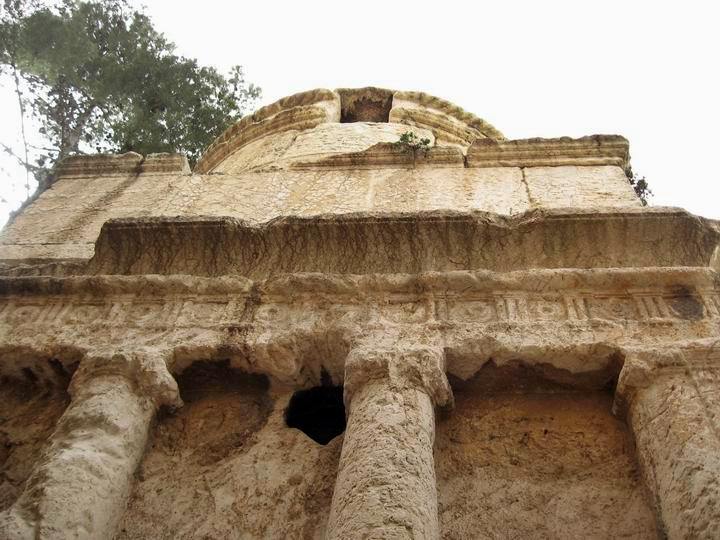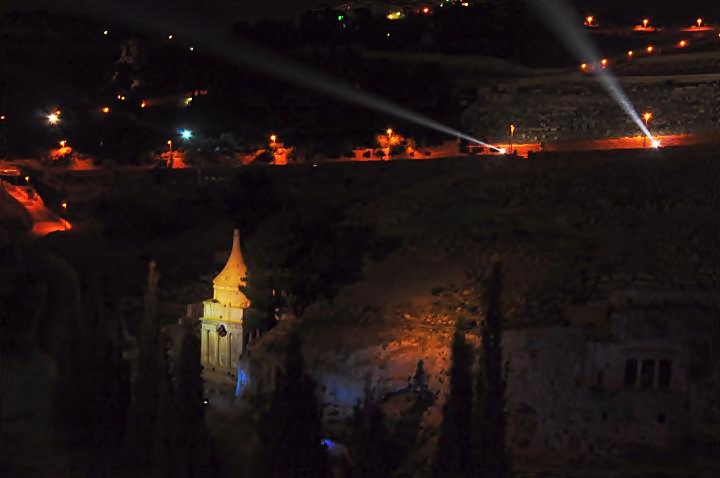This grand monument is built into the rock on the foothills of Mount of Olives. The bible tells us that this is the tomb of Avshalom (Absalom), son of David, who was killed by David’s men after a failed mutiny.
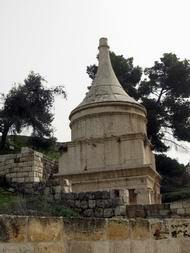
Home > Sites > Jerusalem > Tomb of Absalom; Yad Avshalom
Contents:
Overview
Location
History
Design
Photos
* Mt Olives
* Monument
Biblical References
Historical References
Etymology
Overview:
The Tomb of Avshalom (Absalom) is an ancient monument located in the Kidron Valley, just outside the Old City walls. According to tradition, it is the burial place of Absalom, the rebellious son of King David in the Old Testament. The tomb is carved from solid rock and features a conical roof, with an inscription in Hebrew dating back to the Second Temple period.
2 Samuel 18:18: “…and he called the pillar after his own name: and it is called unto this day, Absalom’s place”
Location:
The tomb is built on the lower western foothills of Mount of Olives, facing the old city of Jerusalem, on the eastern side of Kidron valley. This entire area is a large cemetery with thousands of tombs, and this is one of the famous and largest of all.
History of the place:
-
Death:
Avshalom (Absalom), the third son of David, led a mutiny against his father. After he was defeated, Avshalom fled away on a donkey. However, his long hair caught on the branches of a large oak, he was caught midair, and was subsequently killed. The drawing on the right illustrates this event (Avshalom and the donkey are on the center right side).
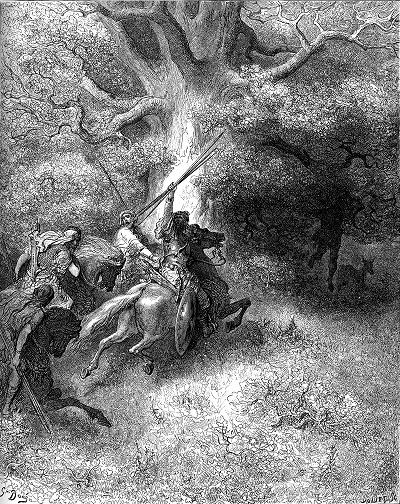
Death of Absalom – Drawing by Gustav Dore (French artist, 1832-1883)
- First Burial:
He later came to rest in this monument. According to the Bible, the tomb was built by Avshalom himself in his lifetime, since he had no sons who would build the tomb. Note that this passage contradicts Chapter 14 where we were told he had 3 sons, but maybe they died earlier, or were not worthy of erecting this memorial. ( 2 Samuel 18: 18):
“Now Absalom in his lifetime had taken and reared up for himself a pillar, which is in the king’s dale: for he said, I have no son to keep my name in remembrance: and he called the pillar after his own name: and it is called unto this day, Absalom’s place”.
-
David mourns:
After hearing of the death of his son, King David mourns Absalom (2 Samuel 18: 32-33) :
“And the king said unto Cushy, Is the young man Absalom safe? And Cushy answered, The enemies of my lord the king, and all that rise against thee to do thee hurt, be as that young man is.
And the king was much moved, and went up to the chamber over the gate, and wept: and as he went, thus he said, O my son Absalom, my son, my son Absalom! would God I had died for thee, O Absalom, my son, my son!”.
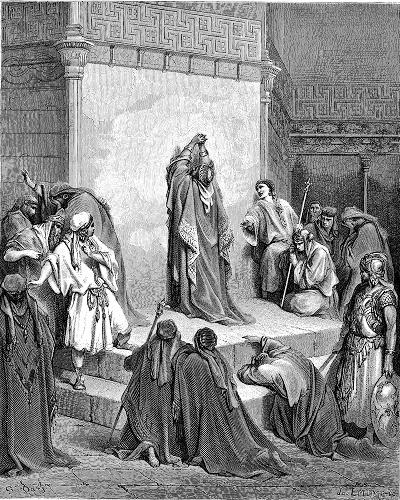
David mourns Avshalom’s death – Gustav Dore
The monument:
According to legend, on top of the top of the tomb was a hand, since in Hebrew the hand (Yad) means “memorial”. Later it was removed, maybe blown away, as a protest of the son’s acts against his father. For 3,000 years the site was covered by small rocks, thrown on the tomb by visitors that showed their disgust against the acts of the son raising against his father.
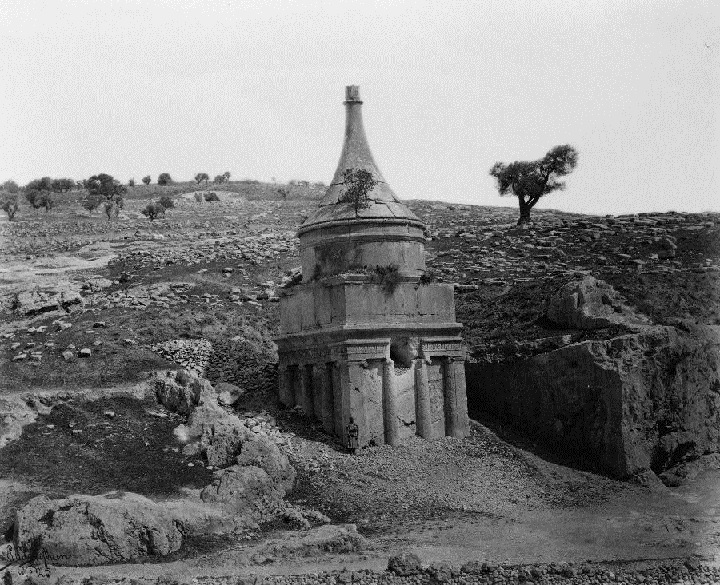
Absalom tomb – photo by P. Bergheim, 1860-1880 – Photos of the Library of Congress
In 1925 the stone piles, seen around the tomb in the 19th century photo above, were removed. The area around the tomb was cleaned.
In 2003 a 4th century AD Greek inscription was detected on the facade of the tomb, which refers to the father of John the Baptist. It reads “This is the tomb of Zachariah, martyr, very pious priest, father of John”. It was added by Byzantine Christians who identified the tomb as the tomb of John’s father. [Thanks to David Adams who added this note]
The entire tomb is cut into the natural rock and is indeed a remarkable memorial. The bible tells us that Avshalom was one of the beautiful men in his lifetime with long hair, and this royal structure indeed captures this beauty and the long hair (the tall head) .
The monumental tomb has an elegant design: the lower part of the monument is a square base, and top of of it is a 3M round drum. On the top section is a concaved cone with a flower engraved on its top.
This design is attributed to 1st century AD structures, and so the memorial may have been constructed at later times than the lifetime of Avshalom (a thousand years earlier).
Note:
Over time monuments, buildings and trees have been erected to memorialize someone’s passing. While a massive structure can sometimes symbolize that person’s great accomplishments, memorial trees can be a symbol of new grown life to honor those that have died and in doing so, their memory lives on.
Photos:
(a) Mount of Olives:
The monument is located on the bottom of the ancient cemetery of Mount of Olives, in the valley of Jehoshaphat.
Click on the photos to view in higher resolution…
A closer view of the tomb and the cemetery is seen in the next photo. Notice the size of the monument in relation to the visitors walking near it.
(b) The monument:
A view of the front of the tomb is shown in this photo.
The north side of the tomb is shown below. On the rock behind the tomb is another set of rock-cut tombs, called Maarat Yehoshafat – cave of King Jehoshaphat. It is a cluster of burial caves, and consists of 8 chambers. The entrance to these caves is closed with an Iron gate. This burial cluster may have been built at the same time of the front structure – at the 1st century AD.
Another view from the rear, looking up.
In June 2010, as part of the Jerusalem Light Festival, the tomb was illuminated with special effects. The following photo is a sample of the illuminated tomb, with Mt Olives in the background.
Biblical References:
(a) 2 Samuel 3:3 :
Avshaolm first appears in the bible in this chapter – the 3rd son of David, a grandson of Talmai from Geshur, a kingdom north-east of the Jordan.
“And his second, Chileab, of Abigail the wife of Nabal the Carmelite; and the third, Absalom the son of Maacah the daughter of Talmai king of Geshur;”
(b) 2 Samuel 14:325:
Avshalom was a beautiful prince, with long hair:
“But in all Israel there was none to be so much praised as Absalom for his beauty: from the sole of his foot even to the crown of his head there was no blemish in him. And when he polled his head, (for it was at every year’s end that he polled it: because the hair was heavy on him, therefore he polled it:) he weighed the hair of his head at two hundred shekels after the king’s weight.”.
(c) 2 Samuel 18:9:
Avshalom led a mutiny against his father, King David, and crowned himself in Hebron. After David’s men managed to defeat his troops, Avshalom fled away on a donkey. However, his long hair caught on the branches of a large oak, and he was caught midair.
Yoav (Yoab), David’s commander, was told on this, and he wounded him with 3 spears in the heart, then his men killed Avshalom, in spite of David’s orders to spare “the boy”.
“And Absalom met the servants of David. And Absalom rode upon a mule, and the mule went under the thick boughs of a great oak, and his head caught hold of the oak, and he was taken up between the heaven and the earth; and the mule that was under him went away. And a certain man saw it, and told Joab, and said, Behold, I saw Absalom hanged in an oak. And Joab said unto the man that told him, And, behold, thou sawest him, and why didst thou not smite him there to the ground? and I would have given thee ten shekels of silver, and a girdle. And the man said unto Joab, Though I should receive a thousand shekels of silver in mine hand, yet would I not put forth mine hand against the king’s son: for in our hearing the king charged thee and Abishai and Ittai*, saying, Beware that none touch the young man Absalom. Otherwise I should have wrought falsehood against mine own life: for there is no matter hid from the king, and thou thyself wouldest have set thyself against me. Then said Joab, I may not tarry thus with thee. And he took three darts in his hand, and thrust them through the heart of Absalom, while he was yet alive in the midst of the oak. And ten young men that bare Joab’s armor compassed about and smote Absalom, and slew him”.
* Webmaster note: My brother, Itai, is mentioned in this text. Ittai (from the city Gat) was David’s close allay, and commanded 600 men.
(d) 2 Samuel 18:17-18:
Avshalom was initially buried by Yoav (Yoab) in a pit near the battlefield, which is located near the Gilad (west to the Jordan river). Later, he was buried in the grand monument called Yad-Avshalom (the featured site), which according to the bible was built by Avshalom himself before he died.
“And they took Absalom, and cast him into a great pit in the wood, and laid a very great heap of stones upon him: and all Israel fled every one to his tent. Now Absalom in his lifetime had taken and reared up for himself a pillar, which is in the king’s dale: for he said, I have no son to keep my name in remembrance: and he called the pillar after his own name: and it is called unto this day, Absalom’s place”.
(e) 2 Chronicles 17:1-3:
This text descibes the Kingdom of Jehoshaphat, the 4th King in Judah. The cluster of burial caves behind Avshalom tomb is called Ma’arat Yehoshafat (the cave of Jehoshaphat).
“And Jehoshaphat his son reigned in his stead, and strengthened himself against Israel. And he placed forces in all the fenced cities of Judah, and set garrisons in the land of Judah, and in the cities of Ephraim, which Asa his father had taken. And the LORD was with Jehoshaphat, because he walked in the first ways of his father David, and sought not unto Baalim;
“Now Jehoshaphat slept with his fathers, and was buried with his fathers in the city of David. And Jehoram (Yoram) his son reigned in his stead”.
Historical References:
Josephus Flavius (Antiquities, Book 7, Chapter 10: 3)
Josephus, the commander-turned-historian, wrote in the 1st century AD that the marble pillar is 2 furlongs (400M) from Jerusalem, which is where the site is located.
“Now Absalom had erected for himself a marble pillar in the king’s dale, two furlongs distant from Jerusalem, which he named Absalom’s Hand, saying, that if his children were killed, his name would remain by that pillar; for he had three sons and one daughter, named Tamar, as we said before, who when she was married to David’s grandson, Rehoboam, bare a son, Abijah by name, who succeeded his father in the kingdom; but of these we shall speak in a part of our history which will be more proper. After the death of Absalom, they returned every one to their own homes respectively”.
Etymology (behind the name):
-
Har Hazeitim – In Hebrew: Har (Mount) Ha (the) Zeitim (Olives)
-
Absalom – In Hebrew: Av-Shalom, where Av is father, and Shalom is peace. Thus the name means “Father of peace”.
-
Yad – Hebrew: memorial, and also “hand”.
-
Ma’arat – From Hebrew: “the cave of”.
-
Yehoshafat (Jehoshaphat) – from Hebrew: Yeho – God, Shafat – judged. Thus the name means: ” God has judged”.
Links:
* Other:
- Biblical pictures by Gustave Doré (1832-1883) – public domain
BibleWalks.com – walk with us through the sites of the Holy Land
Pater Noster<—previous site–<<< All Sites >>>—next Jerusalem site–> Tomb of Zechariah
This page was last updated on Feb 25, 2023 (misc fixes)
Sponsored links:
